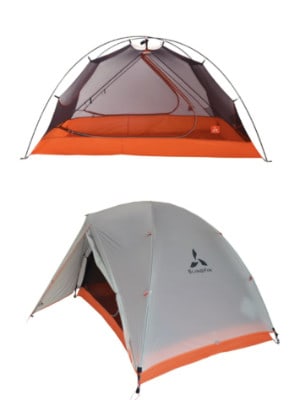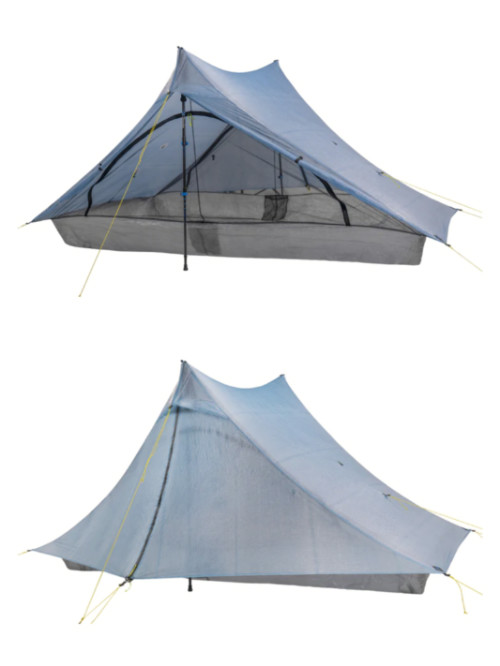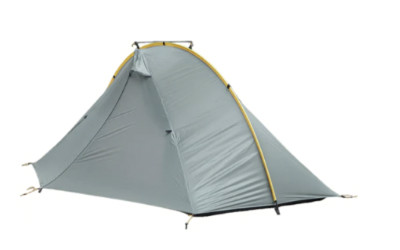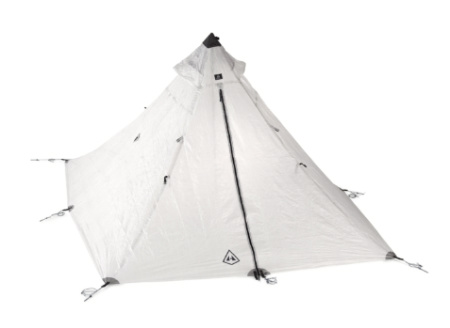
There are so many great one-person and two-person backpacking tents available today, that choosing between them has become one of the biggest challenges faced by many backpackers. For example, improved tent fabrics and lighter weight tent poles have reduced the weight of tents so much that many people purchase two-person tents for solo use because they want more room to spread out or to bring a canine companion. Whatever your preference, here are the 10 best one-person and two-person backpacking tents that we recommend to hikers based on weight, price, livability, durability, weather-worthiness, ease of use, and ventilation. Be sure to read our Tent Selection Advice at the bottom of this article for more insight on how to choose between these fabulous options.
1. Big Agnes Copper Spur HV UL 2 (2P)
The Big Agnes Copper Spur HV UL2 is the most popular two-person backpack tent and with good reason. This freestanding tent is easy to set up and has two doors so you can get in and out without having to crawl over your companion at night. It has a spacious interior with lots of headroom and vertical sidewalls so you can change clothes and sit up inside without touching the sides. Awning-style vestibules expand the covered living space, which is great for both drizzle and sun protection, while two-way door zippers let you vent warm air without compromising privacy. Off-the-floor storage in the form of an oversized ceiling pocket in the head, side pockets, and media pockets provide plenty of space for personal items you want close at hand. Weighing just 2 lbs 11 oz, the Copper Spur is an exceptionally lightweight but fully featured backpacking palace.
Read the SectionHiker Copper Spur HV UL2 Review. 2. NEMO Dagger OSMO 2 Tent (2P)
The NEMO Dagger OSMO 2P Tent is a spacious freestanding double-wall tent for two people with two doors and two vestibules. Weighing 3 lbs 6 oz, the tent is made with NEMO’s OSMO polyester/nylon ripstop fabric which reduces rain fly sag when wet and improves waterproofing. The spacious interior and numerous livability accents make the Dagger OSMO 2P a great tent for tall people or couples who want more room to spread out.
Read the SectionHiker Dagger OSMO 2 Review.
3. Zpacks.com Duplex Zip Tent (2P)
The Zpacks Duplex Zip is a single-wall trekking pole tent that only weighs 19.0 ounces. It has ample space for one person plus gear but can also fit two people comfortably. It has two doors so you get good ventilation and vestibule space on both sides of the tent but you can zipper the doors closed for increased wind protection and stability. The Duplex Zip has a full bathtub floor, taped seams, and mesh sidewalls for insect protection. Pitching the symmetrical tent structure requires two trekking poles, but the dual apex structure is quite strong and wind-resistant. The Duplex is made with an ultralight waterproof material called
Dyneema Composite Fabric, which is waterproof and won’t sag at night or when it rains. It is translucent, however, which can compromise your privacy when camping near others.
Read the SectionHiker Duplex Zip Review. Shop at Zpacks4. Tarptent Rainbow (1P)
The Tarptent Rainbow is one of the few ultralight tents available today that does not require trekking poles to pitch. Instead, it comes with two poles, a long central one and a short brow pole that create a large internal living space that can fit a 25″ sleeping pad with ease and create two full-size vestibules that provide ample gear storage space. The Rainbow is easy to set up because the fly and floor are fully integrated and the interior will stay dry even if you need to pitch it in the rain. It is made with 30D double ripstop 100% silicone coated nylon 66 rated to over 3,000mm hydrostatic head for excellent strength and durability, even in very heavy rain.
5. Durston X-Mid 1 (1P)
The Durston X-Mid 1P is a 28-ounce double-wall trekking pole tent that is exceptionally easy to set up. This 2-door tent is made of 20D polyester with a 2500mm sil/PEU coating and requires trekking poles to pitch. All of the seams are taped and the inner tent is optional so you can just use the rainfly if desired. The X-mid can be set up fly first in the rain to keep the inner tent dry and has plenty of interior gear storage space. This mid-style tent is quite stormworthy and includes extra guy-out points for extreme conditions.
Read the SectionHiker X-Mid 1P review.
Shop at Durston Gear6. Six Moon Designs Lunar Solo (1P)
The Six Moon Designs Lunar Solo is an ultralight style, single-wall tent that’s pitched with a single trekking pole. Weighing 26 ounces, the Lunar Solo has a bathtub style floor to prevent flooding in the rain and a side door, making entry easy. The interior is quite roomy, with a hexagon-shaped floor, providing room to store your gear in the tent, and plenty of headroom to sit up inside. A large vestibule also provides gear storage and room to cook in bad weather. The Lunar Solo upper is made with a 20d silicone-coated polyester, reducing fabric stretch and packed volume, while the floor utilizes a durable 40D fabric.
Read the SectionHiker Review.
7. Hyperlite Mountain Gear UltaMid 2 (2P)
The Hyperlite Mountain Gear (HMG) UltaMid 2 is an ultralight floorless single-wall pyramid made with Dyneema Composite Fabrics that has dual peak vents to help mitigate internal condensation. Weighing just 1 lb 3.1 oz, it requires two ski/trekking poles (lashed together) to set up and has a rectangular footprint that is 83″ wide x 107″ long with a peak height of 64″. If your goal is to minimize your gear weight for winter backpacking, mountaineering, or backcountry touring, you can dig out a sleeping area under the UltaMid and arrange your sleep system (sleeping bag/quilt and pad) on top of a simple plastic sheet.
View at Hyperlite8. NEMO Dragonfly OSMO 2 Tent (2P)
The NEMO DragonFly OSMO 2 is a lightweight freestanding two-person tent with two doors and two oversized vestibules that provide ample storage for backpacks and wet hiking boots. Weighing 2 lbs 10 oz, the tent is made with NEMO’s new OSMO polyester/nylon ripstop fabric which reduces rain fly sag when wet and improves waterproofing. The tent’s exoskeleton architecture comes with prebent tent poles that maximize head and shoulder space, providing plenty of room inside to change clothes or sit out rainy weather, while large D-shaped doors make it easy to enter and exit the tent and can also be rolled back in hot weather for extra ventilation. Overhead light pockets at both ends use special light-diffusing fabric to cast an even glow throughout the tent while interior gear pockets in the corners offer occupants ample storage for personal items.
Read the SectionHiker DragonFly 2 Review. 9. Gossamer Gear “The Two” Tent (2P)
Gossamer Gear’s “The Two” Tent is a single-wall trekking pole tent with two doors and two spacious vestibules. While it’s made by a smaller gear company, it’s very well built, with fully taped seams, excellent waterproofing, great headroom and length for taller campers, interior clotheslines, and gear pockets that make it a joy to use. Weighing just 23.5 oz, it’s also really lightweight and packs up small (11″ x 5″) in part because you use two trekking poles to set it up (tent poles are available separately). The Two is a great tent for warmer weather in milder conditions and is still quite affordable.
Shop at Gossamer Gear10. SlingFin Portal 2 (2P)
The Slingfin Portal is a lightweight two-person tent that can be used year-round in more extreme weather (Slingfin was founded by Martin Zematis, the guy who started Mountain Hardware). Weighing just 2 lbs 13 oz, it has a unique internal guyline system that adds superb wind resistance without additional weight. Two large vestibules and numerous internal pockets provide best-in-class livability, while its freestanding, dome-shaped exoskeleton makes it easy to set up. Kickstand door vents provide unrestricted cross-tent airflow for excellent condensation management without sacrificing weather protection.
Read the SectionHiker SlingFin Portal Review.
Shop at SlingFinTent Selection Criteria
Here are the most important variables to consider when buying a backpacking or camping tent.
Tent Weight/Trail Weight
The total weight of a tent usually measures the tent and all of its packaging, while the trail weight is the weight of its poles, inner tent, outer rain fly, minus any tent stakes. Why the difference? Most people replace the tent stakes that come with a tent with lighter weight or stronger ones and leave all the extra stuff sacks and packaging at home rather than carry it.
Tent Poles/ Trekking Poles
Tent poles are made using fiberglass, aluminum, or carbon fiber. Aluminum is the most durable of the three, while carbon fiber is normally only used in very high-end tents where the focus is on light weight. Fiberglass poles are the least durable tent poles and break frequently. So much so, that we recommend avoiding any tent with fiberglass poles. All the ones above have aluminum poles or use trekking poles. Most manufacturers who sell trekking pole tents offer regular tent poles as an add-on purchase.
Trekking poles tents are quite strong and wind-resistant as long as your trekking poles are in good working order. They’re a good option if gear weight is your chief concern.
Durability
The floor of a tent is the part of a tent most likely to be punctured or torn as a result of ground abrasion. While using a footprint on floors that are 20 denier thick or less is always recommended, it’s far less necessary on 30 denier or higher floors, except on highly abrasive or rough terrain.
Number of Doors
Tents with two side doors are often preferable when purchasing a tent for two because it means each occupant can each get in and out without disturbing one another. One person tents with two doors are also quite convenient, especially in bad weather, since you can cook under one vestibule and store gear in the second.
Interior Storage
Interior pockets and storage organization is a plus in a multi-person tent. Look for internal pockets and gear loops to hang gear from the ceiling. A gear loft is an added bonus. Vestibule space is always a plus as well, but especially if there are multiple doors so that gear storage does not block entry and exit.
Ventilation
All tents experience tent condensation, but good tent site selection and ventilation are the best ways to avoid it. Look for tents that have lots of mesh netting to facilitate airflow, top vents to release moist air, and door tie-backs to roll up tent doors and keep them open at night.
Check Out All of SectionHiker's Gear Guides!
SectionHiker is reader-supported. We only make money if you purchase a product through our affiliate links. Help us continue to test and write unsponsored and independent gear reviews, beginner FAQs, and free hiking guides.



 SectionHiker.com Backpacking Gear Reviews and FAQs
SectionHiker.com Backpacking Gear Reviews and FAQs 






Love my xmid-1. It sets up so easy and live the two doors.
I like the weight savings of a single wall but just not ready to go there yet. Perhaps with more experience.
For now the xmid seems a good balance for me.
When you click on the link for the REI Quarter Dome SL1 it says the tent is no longer available. However, the SL 2 version is in stock and on sale until September 7.
I guess they sold out fast.
Hi Phillip, I’m looking for a 2P 3 season tent that has to withstand occasional high winds and torrential rain. i have your Nemo Hornet 2 review bookmarked, and it was my first option. Is htere a reason you havent included it here – your review was very positive?
Thanks, Neil.
PS: I purchased a Granite Gear Crown 2 on your advice (over a Gossamer Gear Gorilla I was looking at). Very happy with it. Thanks!
There’s no huge difference between the Hornet and the DragonFly. We prefer the DragonFly slightly because it’s a newer model that benefits from Nemo’s experiences with the Hornet over a period of several years. But the problem with any freestanding or semi Freestanding tent in torrential rain is that the inner will get soaked in rain when you put it up. If you have to pitch a tent in such circumstances and high winds (above 25 mph) are a concern, I’d really recommend you go with the X-Mid. The Rainbow would be my first choice if you don’t use trekking poles.
Tried out the XP 1P this year and love it no tent poles so it fit great into my pack. Easy to set up great storage outside the inner tent for sleeping, the vestibule on both sides. Kept out the rain. Easy to get in and out of the tent and rainfly and two doors and 2 rainfly doors. Lightweight and a great color that matches the outdoors where I went. Once the walking poles are up I take the fishing poles instead to different lakes and fish. I also have the XP 2P. The price was great for these tents too.
I think you mean the X-Mid, not the XP.
I have used the NEMO Dragonfly for a few years. One key strength is the fly attaches to the poles with velcro bands and provides guy anchors at those points. This means the tent can handle windy conditions that many lightweight tents cannot. I have used the tent for a late summer ascent of Glacier Peak with a lot of wind and with thoughtful preparations it handled it (this was clearly beyond the intention of this tent and the mesh provides minimal protection and only sifts large particles into small particles to cover everything with fine dust). The point is most lightweight tents cannot stand much wind and this one can.
All double wall tents have velcro or some other fastener to attach the fly to the poles.thats not unique. Most people don’t bother doing it because it’s not really necessary except in windy conditions.
Philip, BIG ASK here – BUT, given your personal experience with so much gear makes you uniquely qualified (& my torso is 19 as well), what would be your solo tent & backpack choices under the following circumstances? 1) primary use location: Appalachian Mtns, Pisgah, Smokies, AT; 2) mostly 2 – 4 night trips; 3) sub-20 lb base weight goal (maybe sub-15), with rare max load capability around 35-40 lb; 3) 3+ season capability, storm-worthy – dabble with pushing into winter a bit; 4) small inner experience ok if nec.; & 5) again, weight is key; 6) Bear canister almost always.
I’ve been devouring your content & am currently fond of SO Flight One, EH Kalais XT & ULA Circuit packs (would like some frame set & maybe load lifters) & TT DCF trekking pole tents (Notch Li, Aeon Li, SS Li) but objectively trying to guard against infatuation with trekking pole tent over free-standing. I like everything about the SS Li but have some reservations about how much space it takes up (perhaps it’s not untenable?) Not a fan of sub-2000 hydrostatic head rating or 7D/15D walls, but have had no experience with them (so not speaking from authority). Tent bulk or vertical packing requirements are less important to me than weight.
Assuming price is not a factor (it is, but a truly lightweight kit is paramount to me reintroducing backpacking to my hiking lifestyle… my kit as a younger man in the 80’s was crazy heavy – Moss dome tent, Dana & ArcTeryx packs & tons of stuff- & frankly it was unpleasant even then). When you have the time, could you help?
I sincerely appreciate it. And your commitment to unbiased, highly useful content. Steve H
My preference is to use a hammock on the AT for privacy, peace and quiet, and flexibility, although not during snake seasons down south. For ground use, I’d go with a TT protrail (li or sil) for 3 season weather. For a pack, I just use a HMG 3400 or a GG Crown2 60.
Mr. Werner, could you explain the reason for NOT using a hammock during snake season? Thanks.
Sure. I don’t particularly like camping where there other people, especially along crowded trails like the AT. That means I camp off-trail by walking into the woods (bushwhacking) where there are likely to be more snakes hiding in ground cover. Since I don’t particularly like copperheads and rattlesnakes, and fear them, I won’t use a hammock down south in warmer weather. Up north in New Hampshire, I do all the time. But we have no poisonous snakes.
Ah! Got it. It isn’t the hammock as much as it is the bushwhacking. Thanks.
Yes.
I do love that sleeping pad. I already responded to your other request.
Thanks Philip, I saw your response. Protrail has great space & weight – not sure about it for camping on exposed balds nor crawling around on my knees. But worth a second look. Re HMG 3400, interesting. I recall you preferring SO Flight One over the HMG for Scotland. Again- really appreciate it.
Curious why MLD Doumid never makes these lists.
I own a few of the tents in the list and believe MLD Doumid is a more flexible option. Bonus: it is 4 season tent.
The duomid is not a tent. It’s a tarp. I owned one for years.